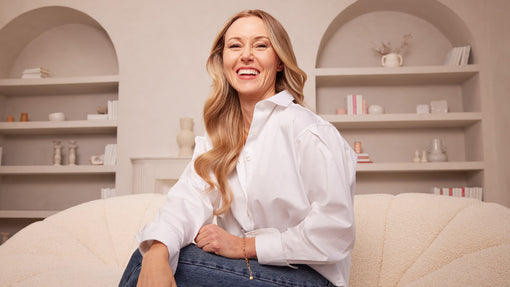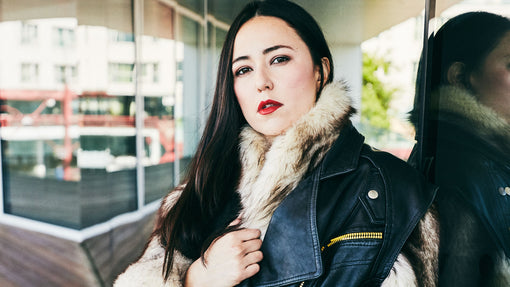
- Article published at:
Nikki is the Creator of The Belle Method and The Bump Method Inc. She fuses Pilates with Pelvic Health, supporting everyone in feeling confident and strong throughout pregnancy, birth, postpartum and beyond.
Why do you feel your work is important? Women's health has been largely neglected in many spheres, and now we're kind of behind in terms of research and how we treat women throughout pregnancy and postpartum. The more we educate women, the more they can advocate for what makes the most sense for them.
After giving birth, so many issues are explained away as just being “part of motherhood.” Women think, “I'll just suck it up.” And, unfortunately, when women have issues with incontinence, pain, or their pelvic floor there aren’t many people saying, “Yeah, this is common, but you don't have to live with it.” I'm very passionate about spreading the word because I think women internalize a lot of shame about issues with fertility, miscarriages, and complications with pregnancy when so often they’ve done nothing wrong.
How did you get started doing this? I was a dancer. I injured my knee, found pilates, rehabbed it, and it was life changing. After that, I started working out of a physiotherapy clinic. In my mid-twenties, I felt I had no business teaching pilates to firefighters with herniated discs, and 65-year-olds with osteoporosis, and a teen with scoliosis and a rod in her back. But those were my clients. And so, I studied hard before each session and asked the physios, chiropractors, and massage therapists what I could do with each person. I learned so much from them early on.
Then, I started to make group classes. I was really able to fuse my dance background with my injuries and special populations background, which helped me create a class that would be a fun, energizing, accessible workout.
I started getting a lot more pregnant women coming, and I thought: “Ooh, you guys need your own thing.” So, I started classes for pregnancy and postpartum.
"I think if we really focus on empathy, community, and support, there's nothing we can't accomplish."
What’s something you wish someone talked to you more about when you were younger?Pelvic health. When I was starting out, 70% of women in my postpartum class were joking about having bladder problems. I had no kids then. I was still in my twenties and I thought, “I need to learn more about this. I don't think this is the way it's supposed to be.” Then, after having my own kids in my thirties, my interest in pelvic health sort of just grew and grew. So, I'm not going to stop talking about it.
I also really believe in community over competition. And I think that’s something we really need to teach our young girls about. There's this societal myth that women are catty and cruel to each other, and I really have found the opposite to be true. I think if we really focus on empathy, community, and support, there's nothing we can't accomplish.
Can you share one of the hardest things to overcome in your work? I spend a lot of time convincing my students that it's never too late to improve their pelvic health. A lot of people think that peeing their pants, or having symptoms of heaviness, or having bad diastasis means it's over for them. But I have students in their 60s who are improving their quality of life, improving their pelvic health, and just feeling better in their own bodies.
After pregnancy there's a lot of trying to slim down, lose weight, and take up less space to fit a certain aesthetic. I like to come from a place of function. Let’s just work to help our bodies function well. Let’s come from a place of gratitude, especially if you've carried a pregnancy, for everything our bodies have been through and helped us through.
"Let’s come from a place of gratitude, especially if you've carried a pregnancy, for everything our bodies have been through and helped us through."
How are taboo topics about women's bodies, women's health, pregnancy and postpartum sex holding women back?Let's talk about postpartum sex. We are often cleared at six weeks to say we can resume all normal activities, including penetrative intercourse, and some women internalize that as pressure. It’s like “You’ve got to go do this.” And we're not really given any guidance. We're told the advice: “Just use some lube, be on top, have some wine,” and it's like a joke. But a lot of women experience pain, and then they think there's something wrong with them. But they haven't really gotten help. They haven't seen a physiotherapist, or learned about their pelvic floor. This can create a neurological feedback loop where your brain starts to anticipate pain. You can get issues with vaginismus. Or issues with chronic pain during sex. And this is terrible because, again, there's shame. Sometimes your closest girlfriends won’t even talk about this.
Let's talk about the lack of aftercare that women get after major abdominal surgery, like cesarean birth. When you have a cesarean birth they cut through seven layers of tissue. It's a major abdominal surgery, and then they’re like, “You're good. Go for a walk and go home. Take some Advil.” I've had heart surgery myself—it was a catheter ablation, which is a day surgery. It was nothing compared to birth, and yet I got more after care than I did with birth.
"Let's talk about postpartum sex. We're told the advice of just use some lube, be on top, have some wine, and it's like a joke."
What do we all stand to gain by connecting women to their power and inner strength?I honestly believe that women can change the world. Period. Self love can be challenging, especially if you look at your body and you don't recognize yourself, which is unfortunately common. I hope that we can come to this place of gratitude for everything we've been through and then trust that it's never too late to develop the belief that our bodies are stronger than we think. If we can work from a place of self love, I think we can make a lot of headway.
What do you hope people walk away with after working with you? Birth can either be one of the most empowering or traumatizing experiences of your life. And how we are treated, how we are respected, validated, spoken to—everything makes such a huge difference. I get a lot of women in our classes who have had prior traumatic experiences. And it's the most amazing feeling when I hear of a positive birth after that trauma. When I hear women saying things like: “I was able to do it my way” or “I'm not peeing my pants anymore” or “I didn't tear this time and I feel like a million dollars” or “You've given me a feeling of confidence about my body that I thought I had lost”—I get shivers every time.
Writing: Carter Selinger
Learn More









